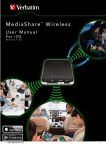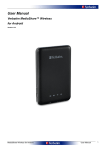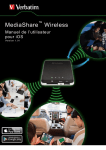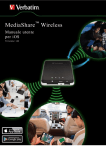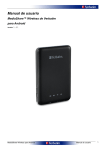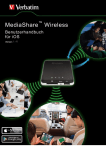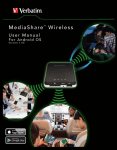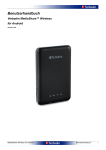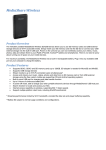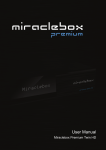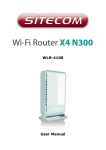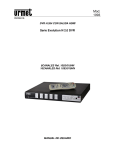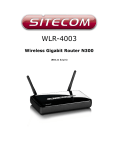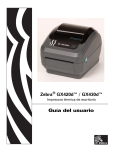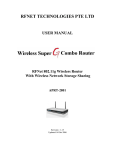Download USER MANUAL
Transcript
MediaShare ™ Manual de usuario para iOS Versión 1.01 Descargar desde la App Store Aplicación Android en Wireless Índice ÍNDICE ......................................................................... 2 ACERCA DE ESTE MANUAL..................................... 3 DESCRIPCIÓN GENERAL DEL PRODUCTO ........... 3 CARACTERÍSTICAS DEL PRODUCTO ............................. 3 MODOS DE FUNCIONAMIENTO ..................................... 3 ESPECIFICACIONES DEL PRODUCTO ............................ 3 REQUISITOS DEL SISTEMA........................................... 3 VISTA DEL PRODUCTO................................................. 4 CARGA DE MEDIASHARE ............................................ 4 INSTALACIÓN DE DISPOSITIVOS DE ALMACENAMIENTO ... 4 Tarjeta de memoria SD ......................................... 4 Almacenamiento externo USB ............................. 4 USO DE DISPOSITIVOS MÓVILES ........................... 5 INSTALACIÓN DE LA APLICACIÓN .................................. 5 CONEXIÓN INALÁMBRICA DE SU IPHONE/IPAD .............. 5 INICIO DE LA APLICACIÓN ............................................ 5 FUNCIONES BÁSICAS .................................................. 6 Reproducción de música ...................................... 6 Reproducción de vídeo ......................................... 7 Visualización de fotos ........................................... 8 Fotos compartidas ................................................ 8 Visualización de documentos ................................9 MODO DE ADMINISTRACIÓN .........................................9 Funciones de copia y eliminación .........................9 MENÚ SETTINGS (CONFIGURACIÓN) ..........................10 Configuración de MyMediaShare ........................10 Configuración Wi-Fi y LAN .................................. 11 Configuración de Internet .................................... 11 Botón Clear Cache (Borrar caché) ......................12 SALIR DE LA APLICACIÓN MEDIASHARE ......................13 DESINSTALACIÓN DE LA APLICACIÓN MEDIASHARE......13 AYUDA .......................................................................13 CONDICIONES DE LA GARANTÍA LIMITADA ........14 CONFORMIDAD CON LAS NORMAS DE LA COMISIÓN FEDERAL DE LAS COMUNICACIONES (FEDERAL COMMUNICATIONS COMMISSION, FCC) ...............14 DECLARACIÓN CE DE CONFORMIDAD ................14 IC RSS-210:2010 DE CANADÁ ................................14 DIRECTIVA SOBRE RESIDUOS DE APARATOS ELÉCTRICOS Y ELECTRÓNICOS (RAEE) ..............14 DERECHOS ...............................................................14 Manual de usuario para iOS 2 Acerca de este manual En este manual se describe el uso del dispositivo SD/USB MediaShare Wireless de Verbatim con smartphones o tablets iOS. Si desea utilizar el dispositivo SD/USB MediaShare Wireless con un smartphone o tablet Android, descargue el manual de usuario «MediaShare Wireless para Android». Descripción general del producto El dispositivo SD/USB portátil MediaShare Wireless de Verbatim le permite utilizar tarjetas de memoria SD y dispositivos USB de almacenamiento externo como soportes accesibles mediante Wi-Fi. Solo tiene que insertar la tarjeta de memoria SD en la ranura SD o conectar el almacenamiento USB externo al puerto USB integrado. Encienda la unidad para acceder de forma inalámbrica a vídeos, música, fotos y datos, y transmítalos a su iPad®, iPhone® y tablet o smartphone Android™. No se preocupe por el espacio disponible en su dispositivo móvil. Para garantizar una portabilidad máxima, MediaShare Wireless dispone de una batería recargable integrada. Para cargarla, conéctela a un puerto USB de su ordenador. Características del producto Compatible con tarjetas de memoria SDXC, SDHC y SD de hasta 128 GB. Para MicroSD y MiniSD se necesita un adaptador SD. Compatible con dispositivos de almacenamiento USB Transmita archivos multimedia mediante Wi-Fi a un máximo de cinco usuarios simultáneamente* Acceda a música, vídeos, fotos y datos y transmítalos desde una tarjeta de memoria SD o desde almacenamiento USB externo con una aplicación personalizada gratuita para móviles compatible con sistemas operativos iOS y Android Puerto micro USB integrado de carga y transferencia de datos Hasta nueve horas de uso continuo de la batería** Con la unidad apagada, puede cargar sus dispositivos electrónicos portátiles conectándolos al puerto USB de MediaShare. Función de búsqueda para encontrar sus archivos y acceder a ellos Puede acceder a Internet de forma inalámbrica, con velocidades 802.11 b/g/n Compatible con herramientas de cliente de varias plataformas, incluyendo iPad/iPhone/Android * El rendimiento de la transmisión está limitado por el ancho de banda Wi-Fi, la velocidad de transmisión de datos del archivo y la capacidad de almacenamiento en búfer del reproductor. Manual de usuario para iOS **La duración de la batería depende de las condiciones habituales de uso y de las configuraciones. Modos de funcionamiento Existen tres modos principales de funcionamiento. 1. Conexión USB directa. Conecte el dispositivo a un puerto USB de su ordenador con el cable USB incluido. El dispositivo aparecerá automáticamente en el escritorio o en «Mi PC». En este modo se cargará la batería de MediaShare Wireless SD/USB, y podrá transferir archivos entre su ordenador y la tarjeta de memoria SD instalada o la memoria USB instalada. 2. Conexión inalámbrica. Encienda el dispositivo y utilice su dispositivo móvil para buscar las conexiones inalámbricas disponibles. Transmita música o vídeos guardados previamente en una tarjeta SD o memoria USB. 3. Modo Wireless WAN Bridge (Puente de WAN inalámbrico). Tras habilitar la función Internet Bridge (Puente de Internet), conecte de forma inalámbrica MediaShare Wireless a su router inalámbrico para acceder a Internet. Especificaciones del producto Dimensiones del producto: 112 mm × 78 mm × 14 mm Radio Wi-Fi: Estándar: 802.11 b/g/n Frecuencia: 2,4 GHz Velocidad: 72 Mbps a 20 MHz/150 Mbps a 40 MHz Seguridad Wi-Fi: WPA-PSK WPA2-PSK WPA/WPA2-PSK mixta (predeterminada) Desactivado Puerto USB 2.0 del dispositivo: Para cargar y transferir datos Batería: Capacidad de 3000 mAh Se carga a través del puerto micro USB B Tiempo de carga de hasta 7 horas Certificaciones reglamentarias: FCC (Clase B), CE, IC RSS-210:2010 (Canadá), CEC-2012-BCS (California, requisito de eficiencia de cargadores de batería) Requisitos del sistema Conexión a Internet (para descargar la aplicación y el manual de usuario, y para el uso con la función opcional Puente de Internet) Aplicación iOS MediaShare Wireless (disponible de forma gratuita en la tienda de aplicaciones iTunes) Debe conectarse un dispositivo de 3 almacenamiento (como mínimo de 1 GB): Tarjeta SD (Clase 4 o superior), memoria USB o unidad de disco duro USB 200 MB de almacenamiento disponible en la tarjeta SD o el dispositivo de almacenamiento USB instalados para funciones del sistema y, por tanto, no disponibles para datos del usuario. iPad, iPhone o iPod Touch con iOS 4.0 o superior. Vista del producto 1 2 3 4 5 9 8 7 6 DESCRIPCIÓN DE LOS COMPONENTES 1. LED de nivel Encendido en verde: La carga de la batería de batería es superior al 30 %. Encendido en rojo: La carga de la batería se encuentra entre el 10 % y el 30 %. Parpadeo rápido en color rojo: Se ha agotado la carga de la batería y la unidad se apagará pronto. Parpadeo lento en color verde (cada 2 segundos): La batería se está cargando. Parpadeo lento en color verde (cada 1,5 segundos): El dispositivo se está apagando. LED apagado: El dispositivo está apagado. 2. LED de En modo de disco Wi-Fi: lectura/escritura Encendido en azul: La memoria se ha conectado correctamente. Parpadeo en color azul: La memoria está leyendo o escribiendo. Durante el modo de lector de tarjetas: Encendido en azul: Conectado a USB2.0 Parpadeo en color azul: Conectado a USB2.0 y en proceso de lectura o escritura. 3. LED de Wi-Fi El LED azul muestra el estado de la conexión Wi-Fi. Si parpadea significa que la iniciación está en curso. Si está encendido significa que el Wi-Fi se ha iniciado. El LED está apagado en las siguientes situaciones: El dispositivo está encendido, pero la señal Wi-Fi es débil. El dispositivo está apagado. El dispositivo está en modo móvil, pero el Wi-Fi está apagado. 4. LED de Verde: Conectado a Internet a través del Internet puente. Apagado: Sin conexión a Internet. 6. Botón Reset (Restablecimiento) 7. Ranura para tarjetas SD Inserte una herramienta pequeña (como un clip) para pulsar el botón y restablecer la configuración predeterminada del dispositivo. Introduzca una tarjeta SD para acceder al Wi-Fi. Introduzca una tarjeta microSD utilizando el adaptador correspondiente. 8. Puerto de dispositivo USB 9. Botón de encendido Utilice el cable USB incluido para conectarse a un ordenador a través de USB 2.0 y habilitar la transferencia de datos. Utilice el cable USB incluido para conectarse a un puerto USB o adaptador de carga USB y cargar el dispositivo Apaga y enciende el dispositivo. Carga de MediaShare Con el cable incluido, conecte MediaShare a un puerto USB o cargador USB activos para cargar la batería integrada. El proceso de carga completa de la batería puede llevar hasta siete horas. Instalación de dispositivos de almacenamiento MediaShare no contiene almacenamiento interno. Debe conectar una tarjeta SD o un dispositivo de almacenamiento USB para utilizar MediaShare con su smartphone o tablet. Una vez conectados su tarjeta SD o dispositivo de almacenamiento USB, MediaShare reservará hasta 200 MB de su capacidad para archivos temporales y otras funciones del sistema. Por lo tanto, este espacio no está disponible para datos del usuario. MediaShare es compatible con dispositivos de almacenamiento que utilicen sistemas de archivos FAT, FAT32, exFAT (para SDXC) o NTFS. Nota: Antes de instalar la tarjeta de memoria SD o el dispositivo USB, asegúrese de que MediaShare Wireless esté apagado. No toque los conectores que están a la vista en su tarjeta de memoria SD. Tarjeta de memoria SD Busque la ranura para tarjetas de memoria SD. Inserte la tarjeta de memoria. Presione con cuidado la tarjeta de memoria para introducirla totalmente y que quede bien colocada. Almacenamiento externo USB 5. Puerto host USB Introduzca una memoria USB o una unidad de disco duro USB para acceder al Wi-Fi. Con la unidad apagada, el puerto USB puede utilizarse para cargar un smartphone o tablet. Manual de usuario para iOS Busque el puerto host USB del dispositivo. Introduzca una memoria USB o el cable de una unidad de disco duro portátil en el puerto USB. 4 Uso de dispositivos móviles Instalación de la aplicación Encienda su dispositivo iOS (iPhone, iPod Touch o iPad) y asegúrese de que esté conectado a Internet. Haga clic en el icono «App Store» del escritorio para acceder a Play Store. Busque la aplicación gratuita «MediaShare Wireless», haga clic en «Instalar» y siga las instrucciones de instalación que aparecerán en pantalla. Una vez completado el proceso de instalación, verá en el escritorio el icono de la aplicación «MediaShare Wireless». Conexión inalámbrica de su iPhone/iPad 1. 1. Encienda MediaShare y espere que se inicialice. El LED azul de Wi-Fi del dispositivo debe dejar de parpadear y permanecer encendido para indicar que el proceso de inicialización se ha completado. Una vez introducida la contraseña correcta, el producto aparecerá como «Conectado» en la lista. Inicio de la aplicación En su dispositivo iOS, haga clic en el icono «MediaShare» para iniciar la aplicación. La pantalla de inicio tiene el aspecto que se indica a continuación. En la pantalla aparecerán carpetas/archivos correspondientes al dispositivo seleccionado (MediaShare o el smartphone/tablet). Puede pasar de la vista de uno de estos dispositivos a la del otro haciendo clic en «MyMediaShare» o en «Mi dispositivo». 2. Haga clic en el icono «Configuración» de su dispositivo móvil. 3. Haga clic en «Wi-Fi». En la lista de redes debe aparecer el nombre de red «Verbatim-XXXX». Haga clic en «Verbatim-866A», por ejemplo. «866A» forma parte del SSID y son los últimos cuatro caracteres de la dirección MAC del dispositivo. En la parte inferior derecha está el botón de menú de tres puntos. Si lo selecciona, este menú presenta las siguientes opciones: Al seleccionar «Verbatim-XXXX» por primera vez, se le pedirá la contraseña del Wi-Fi. La contraseña predeterminada está impresa en la etiqueta situada en la parte inferior de su dispositivo. Manual de usuario para iOS Language (Idioma) Normalmente, el idioma tiene como valor predeterminado el seleccionado en su smartphone/tablet iOS en el momento de la instalación. Si desea seleccionar otro idioma, puede hacerlo desde este menú. Se admiten los siguientes idiomas: Inglés Francés Italiano Alemán Español Portugués Croata Checo Húngaro Polaco Ruso Serbio Chino tradicional Chino simplificado Coreano 5 About (Acerca de) El botón About (Acerca de) muestra los números de versión de la aplicación y el firmware: Cuadro Search (Buscar): buscar el nombre o la extensión de un archivo concreto. Botón 3-dot Menu (Menú de tres puntos): ver la lista del menú para realizar las siguientes selecciones: About (Acerca de), Language (Idioma), Copy (Copiar), Now Playing (En reproducción), Remove USBDisk1 (Eliminar USBDisk1), Remove SDCard (Eliminar SDCard) Copy (Copiar) Haga clic en el botón Copy (Copiar) para ver el estado de la transferencia de archivos. Now Playing (En reproducción) Cuando se está reproduciendo una canción en segundo plano, puede seleccionar el botón Now Playing (En reproducción) para ver información sobre dicha canción. Remove SDCard (Eliminar SDCard) Un volumen SDCard montado puede desmontarse de forma segura utilizando el botón Remove SDCard (Eliminar SDCard). Remove USBDisk1 (Eliminar USBDisk1) Un volumen USBDisk montado puede desmontarse de forma segura utilizando el botón Remove USBDisk (Eliminar USBDisk). Funciones básicas Los botones de las acciones de MyMediaShare están en la parte superior de la pantalla, y son los siguientes: Botón Home (Inicio): volver a la pantalla principal. Botón View (Vista): cambiar a vista de lista o miniaturas. Botón Settings (Configuración): cambiar la configuración de MediaShare Wireless. Botón Back (Atrás): volver a la pantalla anterior Botón Manage (Administrar): administrador de archivos para compartir, copiar, eliminar y transferir archivos Manual de usuario para iOS Reproducción de música Consejo: Recomendamos que cree una o varias carpetas para guardar todos sus archivos de música, pues así le resultará más sencillo utilizarlos y organizarlos Los archivos de música o sonido pueden reproducirse desde «MyMediaShare» o «Mi dispositivo». Simplemente, busque el archivo de música o sonido que desee reproducir. Haga clic en dicho archivo y su música se reproducirá automáticamente. Nota: Consulte el manual de su dispositivo móvil iOS para comprobar que sea compatible con los archivos de música/sonido que desea reproducir. Utilice los siguientes iconos para controlar la reproducción: Al hacer clic en este botón, el archivo de música que se esté reproduciendo se reiniciará desde 0.00. Si hace doble clic en este botón, se reproducirá el archivo de música anterior. Al hacer clic en este botón, se reproducirá el siguiente archivo de música. Al hacer clic en este botón, comenzará la reproducción del archivo de música o sonido. Al hacer clic en este botón, se pausará/detendrá la reproducción del archivo de música. Existen cinco modos de reproducción: 6 1. Repetir todas las canciones: los archivos de música o sonido se reproducirán por orden, y solo dejarán de reproducirse al hacer clic en el botón de pausa. (Modo predeterminado) 2. Reproducir canción actual: se detendrá el archivo de música que se esté reproduciendo y el progreso de la reproducción volverá a 0.00. 3. Repetir canción actual: el reproductor reproducirá siempre la canción actual, y solo dejará de reproducirla al hacer clic en el botón de pausa. 4. 5. Reproducir aleatoriamente todas las canciones: los archivos de música o sonido se reproducirán aleatoriamente. Reproducir lista actual: los archivos de música o sonido se reproducirán por orden. Consejo: Puede mantener pulsado y deslizar el botón de progreso del archivo de música para avanzar rápidamente o rebobinarlo. Consejo: Puede salir de la interfaz del reproductor de música en cualquier momento, y la música continuará reproduciéndose en segundo plano. El rendimiento de la reproducción depende de la velocidad de transmisión de datos del archivo de vídeo, de la potencia de su conexión Wi-Fi y del número de usuarios simultáneos. Si el vídeo se reproduce pero por momentos se congela, puede probar a seguir estos pasos para mejorar el rendimiento de la reproducción de vídeo: 1) Copie el archivo de vídeo en su smartphone/tablet e inicie la reproducción desde dicho smartphone/tablet. 2) Reduzca el número de usuarios simultáneos en streaming. 3) Vuelva a codificar el archivo de vídeo con una velocidad de transmisión de datos inferior. De forma predeterminada, la reproducción de vídeo se realiza en modo horizontal. Utilice los siguientes iconos para controlar la reproducción de vídeo: Al hacer clic en este icono, el vídeo que se está reproduciendo se detendrá, y saldrá de Movie Player Interface (Interfaz del reproductor de vídeo). Al hacer clic en este icono, la escala del vídeo se adaptará al tamaño de la pantalla. Mantenga pulsado y deslice el botón de progreso para avanzar rápidamente o rebobinar el vídeo. Mantenga pulsado y deslice el control de volumen para aumentar o reducir el volumen. Reproducción de vídeo Consejo: Recomendamos que cree una o varias carpetas para guardar todos sus archivos de vídeo, pues así le resultará más sencillo utilizarlos y organizarlos. Los archivos de vídeo pueden reproducirse desde «MyMediaShare» o «Mi dispositivo». Simplemente, busque el archivo de vídeo que desee reproducir. Haga clic en dicho archivo y su vídeo se reproducirá automáticamente. Nota: Consulte el manual de su dispositivo móvil iOS para comprobar que sea compatible con los archivos de vídeo que desea reproducir; los dispositivos iOS suelen ser compatibles con archivos de vídeo H.264 y MPEG-4 en formatos .m4v, .mp4 y .mov. Manual de usuario para iOS Mantenga pulsado este icono para rebobinar rápidamente el vídeo durante la reproducción. Mantenga pulsado este icono para avanzar rápidamente en el vídeo durante la reproducción. Al hacer clic en este icono, comenzará o se reanudará la reproducción del vídeo. Al hacer clic en este icono, se pausará la reproducción del vídeo. 7 Visualización de fotos Consejo: Recomendamos que cree una o varias carpetas para guardar todas sus imágenes, pues así le resultará más sencillo utilizarlas y organizar los archivos. Nota: Actualmente, MediaShare es compatible con archivos de imagen .jpg, .tif, .gif y .bmp Las imágenes compatibles pueden verse como miniaturas o como una lista igual a la de la siguiente captura de pantalla. Las imágenes no compatibles pueden verse como icono o miniatura genéricos. Haga clic en este botón para pausar la reproducción de la presentación, y púlselo de nuevo para continuar dicha reproducción. Haga clic en este botón para reiniciar o repetir la presentación. Haga clic en este botón para reproducir la presentación una vez; la reproducción se detendrá en la última imagen o foto. Haga clic en este botón para volver a la pantalla anterior. Puede añadirse música en segundo plano durante la reproducción de la presentación. Botón Stop/Continue (Detener/continuar) reproducción: detener o continuar la reproducción de la música en segundo plano. Botón Select (Seleccionar): buscar el archivo o los archivos que desee reproducir como música en segundo plano. Haga clic en el botón Return (Volver) para volver a la presentación. Haga clic en cualquier imagen para verla. Botón Repeat (Repetir): si se ha pulsado este botón, la música en segundo plano continuará reproduciéndose. De forma predeterminada, esta opción está desactivada. Fotos compartidas Existen distintas opciones para compartir fotos/imágenes con familiares y amigos, como el correo electrónico, guardarlas en el álbum de fotos del dispositivo o cargarlas en Facebook. Nota: Se necesita conexión a Internet para compartir fotos/imágenes por correo electrónico o acceder a cualquier red social. Cuando haya seleccionado una foto Al hacer clic en este icono, comenzará o se reanudará la reproducción de la presentación. Existen pocas funciones para controlar la presentación. Puede pasar el dedo por la pantalla para ver manualmente las imágenes o hacer clic en el botón de reproducción para reproducir la presentación de forma automática. Manual de usuario para iOS Haga clic en el botón Share (Compartir), situado en la parte superior derecha de la pantalla, para ver las tres opciones disponibles para compartir fotos/imágenes. Haga clic en el botón Return (Volver) para volver a la pantalla anterior. 8 Botón E-Mail (Correo electrónico): al hacer clic en este botón, se iniciará automáticamente la aplicación de correo electrónico predeterminada con la foto/imagen seleccionada como archivo adjunto. Add to photo (Añadir a Fotos): al hacer clic en este botón, la foto seleccionada se guardará en el álbum de fotos del dispositivo, que, de forma predeterminada, será el álbum de cámara. Nota: Para utilizar esta funcionalidad es necesario permitir que MediaShare Wireless acceda a las fotos de su dispositivo. Es posible que se le pida que permita a MediaShare acceder a su álbum de cámara. Es importante acceder a esta petición. Si no lo ha hecho, debe realizar la habilitación dirigiéndose a Configuración -> Privacidad -> Fotos ->MediaShare y cambiando el control deslizante de DESACTIVADO a ACTIVADO Upload to Facebook (Cargar en Facebook): al hacer clic en este botón, irá a la aplicación Facebook si está instalada o la pantalla de inicio de sesión de la página web. Son necesarios los datos de inicio de sesión y la contraseña de Facebook. Visualización de documentos Nota: Para enviar mensajes de correo electrónico se necesita conexión a Internet. Haga clic en el botón «E-Mail» (Correo electrónico): la aplicación de correo electrónico predeterminada se iniciará automáticamente y el documento seleccionado se enviará como archivo adjunto. Una vez enviado el mensaje de correo electrónico, podrá ver el mensaje «Mail Sent» (Correo enviado) en la parte inferior izquierda de la pantalla. Esto indica que el mensaje de correo electrónico se ha enviado correctamente. El mensaje «Mail Canceled» (Correo cancelado) aparecerá en la parte inferior izquierda de la pantalla cuando se cancele el mensaje de correo electrónico. Modo de administración Puede hacer clic en el botón Manage (Administrar) en cualquier momento para pasar al modo de administración de archivos y compartir, copiar, eliminar y transferir dichos archivos. Para salir del modo de administración, haga clic en el botón Done (Listo) . Para administrar archivos en MediaShare, seleccione el modo de administración desde «MyMediaShare». La aplicación MediaShare es compatible con archivos de Keynote, Numbers, Page, Excel, Word, .pdf, .txt y ppt. Para administrar archivos en su smartphone/tablet, seleccione el modo de administración desde «Mi dispositivo». Para abrir o ver documentos, solo tiene que hacer clic en el archivo. Así se abrirá el archivo automáticamente. Funciones de copia y eliminación Haga clic en este botón para volver a la pantalla anterior o Haga clic en este botón para enviar el archivo por correo electrónico tal como se indica en la siguiente captura de pantalla. En la parte inferior de la pantalla hay nuevos iconos. Consulte a continuación sus funciones. Haga clic en el botón Select All (Seleccionar todo) para seleccionar todos los archivos. Aparecerá una marca de verificación azul en cada archivo. Vuelva a hacer clic para cancelar la selección de todos los archivos. Consejo: Puede seleccionar un solo archivo o varios haciendo clic en las miniaturas correspondientes. Copiar archivos. Al entrar en el modo Manage Mode (Administración) desde MyMediaShare, la función de copia realizará una copia de un archivo de MediaShare en el smartphone/tablet. El icono de copia Manual de usuario para iOS 9 contiene una flecha hacia abajo. Nota: La aplicación creará en su dispositivo iOS las carpetas llamadas «Documents» (Documentos), «Movies» (Películas), «Music» (Música) y «Photos» (Fotos). Para acceder a estos archivos debe ir hasta los mismos utilizando la aplicación MediaShare Copiar archivos. Al entrar en el modo de administración desde Mi dispositivo, la función de copia realizará una copia de un archivo de su smartphone/tablet en MediaShare. El icono de copia contiene una flecha hacia arriba. Para copiar archivos debe definir la carpeta de destino. Si lo desea, puede crear una nueva carpeta. Para crear una nueva carpeta, solo tiene que hacer clic en el botón «New Folder» (Nueva carpeta). Introduzca el nombre de la nueva carpeta y haga clic en el botón «Create» (Crear). El nombre de la carpeta puede tener de 2 a 26 caracteres. Consejo: Puede utilizar esta función para realizar copias de seguridad de todos los archivos de fotografía y vídeo del álbum de cámara de sus dispositivos iOS. Puede hacer clic en el icono Status (Estado) para ver la lista de archivos en cola para ser transferidos, y la lista de archivos que ya se han copiado correctamente. Al hacer clic en este icono, se eliminarán los archivos seleccionados. Nota: Los archivos correctamente copiados/transferidos aparecerán en la ventana «Recent» (Recientes). Haga clic en el botón «Clear» (Borrar) para eliminar o borrar la lista. Para salir del modo de administración, haga clic en el botón Done (Listo). Menú Settings (Configuración) Configuración de MyMediaShare Nombre de host <Reservado para funcionalidad futura.> Usuario <Reservado para funcionalidad futura.> Almacenamiento Puede conectar una tarjeta de memoria SD o un dispositivo de almacenamiento USB a MediaShare para funcionar como almacenamiento local. Haga clic en «Storage» (Almacenamiento) para ver el tipo, tamaño y espacio de almacenamiento disponible de cada dispositivo de memoria. Actualización de firmware Visite periódicamente la página web de soporte de Verbatim para ver si se ha publicado un nuevo archivo de firmware para este producto. Si existe un nuevo archivo de firmware, puede descargarlo e instalarlo como se indica a continuación: Nota: Antes de intentar actualizar el firmware, asegúrese de que las baterías de su MediaShare y smartphone/tablet estén totalmente cargadas. 1) Guarde el nuevo archivo en el directorio raíz de una tarjeta de memoria SD o un dispositivo de almacenamiento USB. 2) Conecte el dispositivo de almacenamiento mencionado a su MediaShare y, a continuación, encienda MediaShare. 3) Conecte su smartphone/tablet a MediaShare. 4) Abra la aplicación MediaShare y vaya a la pantalla Settings (Configuración). 5) Haga clic en «Firmware Upgrade» (Actualización de firmware). Se instalará el nuevo archivo de firmware. Cuando se reinicie su MediaShare, perderá la conexión Wi-Fi con su smartphone/tablet. Desde MyMediaShare puede acceder a varias operaciones de configuración haciendo clic en el icono Settings (Configuración). Manual de usuario para iOS 10 Configuración Wi-Fi y LAN No obstante, en este modo, si desea navegar por Internet con su smartphone/tablet, debe inhabilitar la conexión «A» y conectar su smartphone/tablet con un router. Nombre del dispositivo Para cambiar el nombre predeterminado de su dispositivo (SSID), «Verbatim-XXXX», introduzca un nuevo nombre en el cuadro de diálogo que aparecerá. El nombre puede contener cualquier combinación de letras y números, y su longitud máxima es de 32 caracteres. Opciones de seguridad La configuración predeterminada de la seguridad inalámbrica es WPA/WPA2-PSK mixta. La contraseña predeterminada está impresa en la etiqueta situada en la parte inferior del producto. En este cuadro de diálogo puede cambiar la contraseña, seleccionar como seguridad inalámbrica WPA-PSK o WPA2-PSK o deshabilitarla (es decir, no exigir contraseña). Para su comodidad, puede evitar esta situación habilitando la función de puente de MediaShare. En el modo puente de Internet, esbozado a continuación, puede conservar una conexión con el smartphone/tablet y permitir que dicho smartphone/tablet se conecte a Internet (aunque con velocidades limitadas). En este modo, el router define el canal Wi-Fi, y se establecen dos conexiones Wi-Fi («A» y «B») utilizando este mismo número de canal. La contraseña debe tener un mínimo de 8 caracteres y un máximo de 63. Si cambia la contraseña y olvida su nueva contraseña, puede volver a la configuración de seguridad predeterminada utilizando el botón de restablecimiento del panel lateral. Modo La configuración predeterminada del modo de comunicación inalámbrica es 802.11b/g/n. En este cuadro de diálogo puede seleccionar el modo de comunicación 802.11b, 802.11g u 802.11n. LAN En este cuadro de diálogo aparece la dirección MAC fija del producto. También puede ver o cambiar la dirección IP y la máscara de subred. Configuración de Internet Como el router selecciona el canal, y como en diferentes regiones se utilizan distintos intervalos de canales, MediaShare debe conocer su región cuando se habilite la función Internet Bridge (Puente de Internet). Internet Bridge (Puente de Internet) La función Internet Bridge (Puente de Internet) está deshabilitada de forma predeterminada. Para habilitar el puente, haga clic en «On» (Activar), confirme la configuración regional y, a continuación, seleccione su router. Para el funcionamiento normal de este producto solo se necesita una conexión inalámbrica entre su smartphone/tablet iOS y MediaShare. Para realizar esta conexión, MediaShare define el canal Wi-Fi que se va a utilizar (de 1 a 11). La configuración predeterminada de la selección de canal es «automática», lo que permite a MediaShare elegir automáticamente el mejor canal dependiendo de la claridad de los canales del entorno. La conexión se esboza a continuación como conexión «A». Manual de usuario para iOS 11 En cada región se admiten diferentes intervalos de canales Wi-Fi. Si su región no aparece en la lista, elija una región con el mismo intervalo de canales que la suya. Seleccione una red en la lista de redes detectadas por MediaShare Wireless Canal Si Internet Bridge (Puente de Internet) está deshabilitado, puede seleccionar un número de canal Wi-Fi de 1 a 11. La selección predeterminada es «automática», lo que permite a MediaShare elegir el canal con la señal de mayor calidad. Si Internet Bridge (Puente de Internet) está habilitado, MediaShare utilizará el canal seleccionado por el router. Botón Clear Cache (Borrar caché) Haga clic en el botón Clear Cache (Borrar caché) para borrar los archivos caché del SSID guardados en sesiones anteriores o desde aplicaciones de terceros. Guardar configuración Si su router pide contraseña, introdúzcala para unirse a la red. Ajustes opcionales: Es posible que para conectarse a su router también tenga que seleccionar DHCP en vez de IP fija. Si se utiliza una IP fija, introduzca la dirección IP, la máscara de subred, la puerta de enlace y la configuración DNS. Manual de usuario para iOS Pulse el botón Settings (Configuración) para guardar la configuración y activar la función de puente. Pulse OK (Aceptar) para confirmar; tenga en cuenta que es posible que deba conectarse de nuevo a MediaShare. Una vez activada la función Internet Bridge (Puente de Internet), se encenderá el LED verde de Internet Bridge (Puente de Internet). 12 Salir de la aplicación MediaShare Para salir de la aplicación MediaShare en dispositivos iOS, solo tiene que pulsar la tecla Inicio de su dispositivo móvil. Para cerrar la aplicación MediaShare después de salir, haga clic en la tecla Inicio dos veces y la lista de aplicaciones en ejecución aparecerá en la parte inferior de su dispositivo. Mantenga pulsado el icono de la aplicación MediaShare hasta que aparezca el signo menos (-) en la parte superior del icono de la aplicación. Haga clic en el signo menos (-) para cerrar la aplicación. Desinstalación de la aplicación MediaShare Para desinstalar la aplicación de su dispositivo móvil Apple, mantenga pulsada la aplicación MediaShare durante unos segundos. Aparecerá la marca «X» en todos los iconos de su dispositivo móvil, como se ve en la siguiente captura de pantalla. Solo tiene que hacer clic en la «X» situada en la parte superior izquierda del icono MediaShare para quitar la aplicación de su dispositivo móvil. Ayuda Si tiene problemas a la hora de instalar o utilizar su producto Verbatim, visite la página principal de soporte técnico en http://www.verbatim.es/es_9/support.html?con=16. Manual de usuario para iOS 13 Condiciones de la garantía limitada Verbatim ofrece al propietario original una garantía limitada de dos años. Para conocer región, visite http://www.verbatim.es/es_9/article_product-warranty_7012_0.html. las condiciones de garantía en vigor en su Conformidad con las normas de la Comisión Federal de las Comunicaciones (Federal Communications Commission, FCC) Este aparato ha sido probado y se ha demostrado que respeta los límites establecidos en la Parte 15 de las Normas FCC para dispositivos digitales de Clase B. El fin de estos límites es proporcionar una protección razonable contra las interferencias que puedan producirse en instalaciones residenciales. Este aparato genera, usa y puede emitir energía de radiofrecuencia y, si no se instala o no se utiliza tal como se indica en las instrucciones, puede producir interferencias en las comunicaciones por radio. De todos modos, no se garantiza que no se produzcan interferencias en alguna instalación. En el caso de que este aparato produzca interferencias en la recepción de la señal de radio o televisión, lo que puede comprobarse apagando y encendiendo dicho aparato, se recomienda al usuario que trate de eliminar las mencionadas interferencias adoptando una de las siguientes medidas, o varias de ellas: Modificar la orientación o la posición de la antena receptora. Alejar más el aparato del receptor. Conectar el aparato a una toma de un circuito al que no esté conectado el receptor. Consultar al distribuidor o a un técnico de radio o televisión. Este equipo respeta los límites de exposición a la radiación de radiofrecuencia establecidos por la FCC para entornos no controlados. Este transmisor no debe situarse ni utilizarse junto con otra antena u otro transmisor. Este equipo debe instalarse y utilizarse respetando una distancia mínima de veinte centímetros entre el radiador y su cuerpo. Precaución: El fabricante no es responsable de las interferencias de radio o televisión causadas por modificaciones no autorizadas de este equipo. Dichas modificaciones podrían anular el derecho del usuario a utilizar el equipo. Declaración CE de conformidad Este dispositivo cumple los requisitos esenciales de protección de la Directiva de equipos radioeléctricos y equipos terminales de telecomunicación 1999/5/CE y sus modificaciones en la aproximación de las legislaciones de los Estados miembros sobre seguridad eléctrica y de equipos inalámbricos de radio. EN 300 328 V1.7.1: 2006 EN 301 489-1 V1.9.2: 2011 EN 301 489-17 V2.2.1: 2012 EN 55022: 2010 EN 55024: 2010 EN 62479: 2010 EN 60950-1: 2006+A11: 2009+A1: 2010+A12: 2011 IC RSS-210:2010 de Canadá Este dispositivo cumple las normas RSS de Industry Canada/Industrie Canada para dispositivos exentos de licencia. El funcionamiento depende de las dos condiciones siguientes: 1) Este dispositivo no puede producir interferencias, y 2) Este dispositivo debe aceptar cualquier interferencia, incluidas las interferencias que puedan producir un mal funcionamiento del dispositivo. Directiva sobre Residuos de aparatos eléctricos y electrónicos (RAEE) La Directiva Europea sobre Residuos de Aparatos Eléctricos y Electrónicos (DRAEE), que entró en vigor el 13 de febrero de 2003, supone un cambio importante en el tratamiento de los aparatos eléctricos al final de su vida útil. El logotipo RAEE (a la izquierda) que aparece en el producto o en su caja indica que no debe deshacerse de dicho producto ni tirarlo como si se tratase de un residuo doméstico. Para obtener más información sobre la eliminación, el reciclado y los puntos de recogida de residuos de aparatos electrónicos y eléctricos, póngase en contacto con el servicio de eliminación de residuos domésticos de su término municipal o con la tienda en la que adquirió el aparato. Derechos Copyright ©2013 Verbatim Americas, LLC. Ninguna parte de este documento, con la excepción de la siguiente licencia de GNU, puede reproducirse de forma alguna ni por medio alguno, con ningún fin, sin el permiso explícito por escrito de Verbatim Americas, LLC. Todos los derechos reservados. Todos los demás nombres de productos y marcas mencionados en el presente documento pertenecen a sus respectivos propietarios. El firmware integrado en este producto se facilita de acuerdo con los términos de la Licencia Pública General de GNU. Manual de usuario para iOS 14 Información de la Licencia El Verbatim MediaShare Wireless incluye un software de terceras partes con derechos de autor registrado bajo los términos de la Licencia Pública General (GNU). Refiérase por favor a la Licencia Pública General (GNU) en cuanto a sus términos y condiciones. Item Bootloader Name U-Boot Package(Version) U-Boot 1.1.3 Note GPL v2 or later Kernel Linux linux-2.6.21 GPL v2 or later uclibc ldso libm libnsl libpcap-1.0.0 libpthread libiconv libevent libutil libz libsqlite3.so.0 uClibc-0.9.28 ld-uClibc-0.9.28.so libm-0.9.28.so libnsl-0.9.28.so libpcap-1.0.0 libpthread-0.9.28.so libiconv-1.13.1 libevent-2.0.10-stable libutil-0.9.28.so zlib-1.2.3 sqlite-autoconf-3071300 (LGPL) version 2 or later GPL FreeBSD GPL GPL GPL GPL GPL GPL Zlib(Distributable) GPL busybox ntp ntpclient parted samba lighttpd apache hdparm mtd-utils ntfs-3g ez-ipupdatels udev wireless_tools bridge-utils pcre arptable dhcpforwarder ethtool expat igmpproxy inadyn iproute2 iptables acl mii_mgr mtd_write BusyBox v1.12.1 ntp-4.2.4p2 ntpclient parted-3.0 samba-3.0.24 lighttpd-1.4.28 Apache2.2.22 hdparm v7.7 mtd-utils-1.3.1 ntfs-3g_ntfsprogs-2012.1.15 ez-ipupdate-3.0.10 udev-125ps V29 2006-01-31 7.9 arptable-0.0.3 2004-08-19 Ethtool V6 expat-2.0.1 igmpproxy0.1 beta2 inadynVersion 1.96 iproute2-2.6.24-rc7 iptables-1.3.5 acl-2.2.49 mii_mgr mtd_write GPL v2 or later GPL v2 GPL v2 GPL GPL GPL GPL BSD GPL GPL (distributable) GPL GPL GPL BSD GPL Internet Systems Consortium(distributable) GPL Library Application MIT/X Consortium License GPL GPL GPL GPL GPL GPL GPL Todos los softwares mencionados disponen de los derechos de autor de sus respectivos autores. Véase el Código Fuente para más información. Disponibilidad del Código Fuente Verbatim ha puesto a disposición el Código Fuente completo del software registrado GPL, junto a cada guion para gestionar la recopilación e instalación del código objeto. Las actualizaciones de firmware futuras vendrán con su propio Código Fuente. Para más información en cuanto a cómo obtener nuestro Código Fuente de libre acceso, consulte nuestra página Web por favor: www.verbatim.com/mediasharewireless Manual de usuario para iOS 15 GNU GENERAL PUBLIC LICENSE Version 2, June 1991 Copyright (C) 1989, 1991 Free Software Foundation, Inc. 51 Franklin Street, Fifth Floor, Boston, MA 02110-1301, USA Everyone is permitted to copy and distribute verbatim copies of this license document, but changing it is not allowed. Preamble The licenses for most software are designed to take away your freedom to share and change it. By contrast, the GNU General Public License is intended to guarantee your freedom to share and change free software--to make sure the software is free for all its users. This General Public License applies to most of the Free Software Foundation's software and to any other program whose authors commit to using it. (Some other Free Software Foundation software is covered by the GNU Lesser General Public License instead.) You can apply it to your programs, too. When we speak of free software, we are referring to freedom, not price. Our General Public Licenses are designed to make sure that you have the freedom to distribute copies of free software (and charge for this service if you wish), that you receive source code or can get it if you want it, that you can change the software or use pieces of it in new free programs; and that you know you can do these things. To protect your rights, we need to make restrictions that forbid anyone to deny you these rights or to ask you to surrender the rights. These restrictions translate to certain responsibilities for you if you distribute copies of the software, or if you modify it. For example, if you distribute copies of such a program, whether gratis or for a fee, you must give the recipients all the rights that you have. You must make sure that they, too, receive or can get the source code. And you must show them these terms so they know their rights. We protect your rights with two steps: (1) copyright the software, and (2) offer you this license which gives you legal permission to copy, distribute and/or modify the software. Also, for each author's protection and ours, we want to make certain that everyone understands that there is no warranty for this free software. If the software is modified by someone else and passed on, we want its recipients to know that what they have is not the original, so that any problems introduced by others will not reflect on the original authors' reputations. Finally, any free program is threatened constantly by software patents. We wish to avoid the danger that redistributors of a free program will individually obtain patent licenses, in effect making the program proprietary. To prevent this, we have made it clear that any patent must be licensed for everyone's free use or not licensed at all. The precise terms and conditions for copying, distribution and modification follow. TERMS AND CONDITIONS FOR COPYING, DISTRIBUTION AND MODIFICATION 0. This License applies to any program or other work which contains a notice placed by the copyright holder saying it may be distributed under the terms of this General Public License. The "Program", below, refers to any such program or work, and a "work based on the Program" means either the Program or any derivative work under copyright law: that is to say, a work containing the Program or a portion of it, either verbatim or with modifications and/or translated into another language. (Hereinafter, translation is included without limitation in the term "modification".) Each licensee is addressed as "you". Activities other than copying, distribution and modification are not covered by this License; they are outside its scope. The act of running the Program is not restricted, and the output from the Program is covered only if its contents constitute a work based on the Program (independent of having been made by running the Program). Whether that is true depends on what the Program does. 1. You may copy and distribute verbatim copies of the Program's source code as you receive it, in any medium, provided that you conspicuously and appropriately publish on each copy an appropriate copyright notice and disclaimer of warranty; keep intact all the notices that refer to this License and to the absence of any warranty; and give any other recipients of the Program a copy of this License along with the Program. You may charge a fee for the physical act of transferring a copy, and you may at your option offer warranty protection in exchange for a fee. 2. You may modify your copy or copies of the Program or any portion of it, thus forming a work based on the Program, and copy and distribute such modifications or work under the terms of Section 1 above, provided that you also meet all of these conditions: a) You must cause the modified files to carry prominent notices stating that you changed the files and the date of any change. b) You must cause any work that you distribute or publish, that in whole or in part contains or is derived from the Program or any part thereof, to be licensed as a whole at no charge to all third parties under the terms of this License. c) If the modified program normally reads commands interactively when run, you must cause it, when started running for such interactive use in the most ordinary way, to print or display an announcement including an appropriate copyright notice and a notice that there is no warranty (or else, saying that you provide a warranty) and that users may redistribute the program under these conditions, and telling the user how to view a copy of this License. (Exception: if the Program itself is interactive but does not normally print such an announcement, your work based on the Program is not required to print an announcement.) These requirements apply to the modified work as a whole. If identifiable sections of that work are not derived from the Program, and can be reasonably considered independent and separate works in themselves, then this License, and its terms, do not apply to those sections when you distribute them as separate works. But when you distribute the same sections as part of a whole which is a work based on the Program, the distribution of the whole must be on the terms of this License, whose permissions for other licensees extend to the entire whole, and thus to each and every part regardless of who wrote it. Thus, it is not the intent of this section to claim rights or contest your rights to work written entirely by you; rather, the intent is to exercise the right to control the distribution of derivative or collective works based on the Program. In addition, mere aggregation of another work not based on the Program with the Program (or with a work based on the Program) on a volume of a storage or distribution medium does not bring the other work under the scope of this License. 3. You may copy and distribute the Program (or a work based on it, under Section 2) in object code or executable form under the terms of Sections 1 and 2 above provided that you also do one of the following: a) Accompany it with the complete corresponding machine-readable source code, which must be distributed under the terms of Sections 1 and 2 above on a medium customarily used for software interchange; or, b) Accompany it with a written offer, valid for at least three years, to give any third party, for a charge no more than your cost of physically performing source distribution, a complete machine-readable copy of the corresponding source code, to be distributed under the terms of Sections 1 and 2 above on a medium customarily used for software interchange; or, c) Accompany it with the information you received as to the offer to distribute corresponding source code. (This alternative is allowed only for noncommercial distribution and only if you received the program in object code or executable form with such an offer, in accord with Subsection b above.) The source code for a work means the preferred form of the work for making modifications to it. For an executable work, complete source code means all the source code for all modules it contains, plus any associated interface definition files, plus the scripts used to control compilation and Manual de usuario para iOS 16 installation of the executable. However, as a special exception, the source code distributed need not include anything that is normally distributed (in either source or binary form) with the major components (compiler, kernel, and so on) of the operating system on which the executable runs, unless that component itself accompanies the executable. If distribution of executable or object code is made by offering access to copy from a designated place, then offering equivalent access to copy the source code from the same place counts as distribution of the source code, even though third parties are not compelled to copy the source along with the object code. 4. You may not copy, modify, sublicense, or distribute the Program except as expressly provided under this License. Any attempt otherwise to copy, modify, sublicense or distribute the Program is void, and will automatically terminate your rights under this License. However, parties who have received copies, or rights, from you under this License will not have their licenses terminated so long as such parties remain in full compliance. 5. You are not required to accept this License, since you have not signed it. However, nothing else grants you permission to modify or distribute the Program or its derivative works. These actions are prohibited by law if you do not accept this License. Therefore, by modifying or distributing the Program (or any work based on the Program), you indicate your acceptance of this License to do so, and all its terms and conditions for copying, distributing or modifying the Program or works based on it. 6. Each time you redistribute the Program (or any work based on the Program), the recipient automatically receives a license from the original licensor to copy, distribute or modify the Program subject to these terms and conditions. You may not impose any further restrictions on the recipients' exercise of the rights granted herein. You are not responsible for enforcing compliance by third parties to this License. 7. If, as a consequence of a court judgment or allegation of patent infringement or for any other reason (not limited to patent issues), conditions are imposed on you (whether by court order, agreement or otherwise) that contradict the conditions of this License, they do not excuse you from the conditions of this License. If you cannot distribute so as to satisfy simultaneously your obligations under this License and any other pertinent obligations, then as a consequence you may not distribute the Program at all. For example, if a patent license would not permit royalty-free redistribution of the Program by all those who receive copies directly or indirectly through you, then the only way you could satisfy both it and this License would be to refrain entirely from distribution of the Program. If any portion of this section is held invalid or unenforceable under any particular circumstance, the balance of the section is intended to apply and the section as a whole is intended to apply in other circumstances. It is not the purpose of this section to induce you to infringe any patents or other property right claims or to contest validity of any such claims; this section has the sole purpose of protecting the integrity of the free software distribution system, which is implemented by public license practices. Many people have made generous contributions to the wide range of software distributed through that system in reliance on consistent application of that system; it is up to the author/donor to decide if he or she is willing to distribute software through any other system and a licensee cannot impose that choice. This section is intended to make thoroughly clear what is believed to be a consequence of the rest of this License. 8. If the distribution and/or use of the Program is restricted in certain countries either by patents or by copyrighted interfaces, the original copyright holder who places the Program under this License may add an explicit geographical distribution limitation excluding those countries, so that distribution is permitted only in or among countries not thus excluded. In such case, this License incorporates the limitation as if written in the body of this License. 9. The Free Software Foundation may publish revised and/or new versions of the General Public License from time to time. Such new versions will be similar in spirit to the present version, but may differ in detail to address new problems or concerns. Each version is given a distinguishing version number. If the Program specifies a version number of this License which applies to it and "any later version", you have the option of following the terms and conditions either of that version or of any later version published by the Free Software Foundation. If the Program does not specify a version number of this License, you may choose any version ever published by the Free Software Foundation. 10. If you wish to incorporate parts of the Program into other free programs whose distribution conditions are different, write to the author to ask for permission. For software which is copyrighted by the Free Software Foundation, write to the Free Software Foundation; we sometimes make exceptions for this. Our decision will be guided by the two goals of preserving the free status of all derivatives of our free software and of promoting the sharing and reuse of software generally. NO WARRANTY 11. BECAUSE THE PROGRAM IS LICENSED FREE OF CHARGE, THERE IS NO WARRANTY FOR THE PROGRAM, TO THE EXTENT PERMITTED BY APPLICABLE LAW. EXCEPT WHEN OTHERWISE STATED IN WRITING THE COPYRIGHT HOLDERS AND/OR OTHER PARTIES PROVIDE THE PROGRAM "AS IS" WITHOUT WARRANTY OF ANY KIND, EITHER EXPRESSED OR IMPLIED, INCLUDING, BUT NOT LIMITED TO, THE IMPLIED WARRANTIES OF MERCHANTABILITY AND FITNESS FOR A PARTICULAR PURPOSE. THE ENTIRE RISK AS TO THE QUALITY AND PERFORMANCE OF THE PROGRAM IS WITH YOU. SHOULD THE PROGRAM PROVE DEFECTIVE, YOU ASSUME THE COST OF ALL NECESSARY SERVICING, REPAIR OR CORRECTION. 12. IN NO EVENT UNLESS REQUIRED BY APPLICABLE LAW OR AGREED TO IN WRITING WILL ANY COPYRIGHT HOLDER, OR ANY OTHER PARTY WHO MAY MODIFY AND/OR REDISTRIBUTE THE PROGRAM AS PERMITTED ABOVE, BE LIABLE TO YOU FOR DAMAGES, INCLUDING ANY GENERAL, SPECIAL, INCIDENTAL OR CONSEQUENTIAL DAMAGES ARISING OUT OF THE USE OR INABILITY TO USE THE PROGRAM (INCLUDING BUT NOT LIMITED TO LOSS OF DATA OR DATA BEING RENDERED INACCURATE OR LOSSES SUSTAINED BY YOU OR THIRD PARTIES OR A FAILURE OF THE PROGRAM TO OPERATE WITH ANY OTHER PROGRAMS), EVEN IF SUCH HOLDER OR OTHER PARTY HAS BEEN ADVISED OF THE POSSIBILITY OF SUCH DAMAGES. GNU LESSER GENERAL PUBLIC LICENSE Version 2.1, February 1999 Copyright (C) 1991, 1999 Free Software Foundation, Inc., 51 Franklin Street, Fifth Floor, Boston, MA 02110-1301 USA Everyone is permitted to copy and distribute verbatim copies of this license document, but changing it is not allowed. [This is the first released version of the Lesser GPL. It also counts as the successor of the GNU Library Public License, version 2, hence the version number 2.1.] Preamble The licenses for most software are designed to take away your freedom to share and change it. By contrast, the GNU General Public Licenses are intended to guarantee your freedom to share and change free software--to make sure the software is free for all its users. This license, the Lesser General Public License, applies to some specially designated software packages--typically libraries--of the Free Software Foundation and other authors who decide to use it. You can use it too, but we suggest you first think carefully about whether this license or the Manual de usuario para iOS 17 ordinary General Public License is the better strategy to use in any particular case, based on the explanations below. When we speak of free software, we are referring to freedom of use, not price. Our General Public Licenses are designed to make sure that you have the freedom to distribute copies of free software (and charge for this service if you wish); that you receive source code or can get it if you want it; that you can change the software and use pieces of it in new free programs; and that you are informed that you can do these things. To protect your rights, we need to make restrictions that forbid distributors to deny you these rights or to ask you to surrender these rights. These restrictions translate to certain responsibilities for you if you distribute copies of the library or if you modify it. For example, if you distribute copies of the library, whether gratis or for a fee, you must give the recipients all the rights that we gave you. You must make sure that they, too, receive or can get the source code. If you link other code with the library, you must provide complete object files to the recipients, so that they can relink them with the library after making changes to the library and recompiling it. And you must show them these terms so they know their rights. We protect your rights with a two-step method: (1) we copyright the library, and (2) we offer you this license, which gives you legal permission to copy, distribute and/or modify the library. To protect each distributor, we want to make it very clear that there is no warranty for the free library. Also, if the library is modified by someone else and passed on, the recipients should know that what they have is not the original version, so that the original author's reputation will not be affected by problems that might be introduced by others. Finally, software patents pose a constant threat to the existence of any free program. We wish to make sure that a company cannot effectively restrict the users of a free program by obtaining a restrictive license from a patent holder. Therefore, we insist that any patent license obtained for a version of the library must be consistent with the full freedom of use specified in this license. Most GNU software, including some libraries, is covered by the ordinary GNU General Public License. This license, the GNU Lesser General Public License, applies to certain designated libraries, and is quite different from the ordinary General Public License. We use this license for certain libraries in order to permit linking those libraries into non-free programs. When a program is linked with a library, whether statically or using a shared library, the combination of the two is legally speaking a combined work, a derivative of the original library. The ordinary General Public License therefore permits such linking only if the entire combination fits its criteria of freedom. The Lesser General Public License permits more lax criteria for linking other code with the library. We call this license the "Lesser" General Public License because it does Less to protect the user's freedom than the ordinary General Public License. It also provides other free software developers Less of an advantage over competing non-free programs. These disadvantages are the reason we use the ordinary General Public License for many libraries. However, the Lesser license provides advantages in certain special circumstances. For example, on rare occasions, there may be a special need to encourage the widest possible use of a certain library, so that it becomes a de-facto standard. To achieve this, non-free programs must be allowed to use the library. A more frequent case is that a free library does the same job as widely used non-free libraries. In this case, there is little to gain by limiting the free library to free software only, so we use the Lesser General Public License. In other cases, permission to use a particular library in non-free programs enables a greater number of people to use a large body of free software. For example, permission to use the GNU C Library in non-free programs enables many more people to use the whole GNU operating system, as well as its variant, the GNU/Linux operating system. Although the Lesser General Public License is Less protective of the users' freedom, it does ensure that the user of a program that is linked with the Library has the freedom and the wherewithal to run that program using a modified version of the Library. The precise terms and conditions for copying, distribution and modification follow. Pay close attention to the difference between a "work based on the library" and a "work that uses the library". The former contains code derived from the library, whereas the latter must be combined with the library in order to run. TERMS AND CONDITIONS FOR COPYING, DISTRIBUTION AND MODIFICATION 0.This License Agreement applies to any software library or other program which contains a notice placed by the copyright holder or other authorized party saying it may be distributed under the terms of this Lesser General Public License (also called "this License"). Each licensee is addressed as "you". A "library" means a collection of software functions and/or data prepared so as to be conveniently linked with application programs (which use some of those functions and data) to form executables. The "Library", below, refers to any such software library or work which has been distributed under these terms. A "work based on the Library" means either the Library or any derivative work under copyright law: that is to say, a work containing the Library or a portion of it, either verbatim or with modifications and/or translated straightforwardly into another language. (Hereinafter, translation is included without limitation in the term "modification".) "Source code" for a work means the preferred form of the work for making modifications to it. For a library, complete source code means all the source code for all modules it contains, plus any associated interface definition files, plus the scripts used to control compilation and installation of the library. Activities other than copying, distribution and modification are not covered by this License; they are outside its scope. The act of running a program using the Library is not restricted, and output from such a program is covered only if its contents constitute a work based on the Library (independent of the use of the Library in a tool for writing it). Whether that is true depends on what the Library does and what the program that uses the Library does. 1.You may copy and distribute verbatim copies of the Library's complete source code as you receive it, in any medium, provided that you conspicuously and appropriately publish on each copy an appropriate copyright notice and disclaimer of warranty; keep intact all the notices that refer to this License and to the absence of any warranty; and distribute a copy of this License along with the Library. You may charge a fee for the physical act of transferring a copy, and you may at your option offer warranty protection in exchange for a fee. 2.You may modify your copy or copies of the Library or any portion of it, thus forming a work based on the Library, and copy and distribute such modifications or work under the terms of Section 1 above, provided that you also meet all of these conditions: a) The modified work must itself be a software library. b) You must cause the files modified to carry prominent notices stating that you changed the files and the date of any change. c) You must cause the whole of the work to be licensed at no charge to all third parties under the terms of this License. d) If a facility in the modified Library refers to a function or a table of data to be supplied by an application program that uses the facility, other than as an argument passed when the facility is invoked, then you must make a good faith effort to ensure that, in the event an application does not supply such function or table, the facility still operates, and performs whatever part of its purpose remains meaningful. (For example, a function in a library to compute square roots has a purpose that is entirely well-defined independent of the application. Therefore, Subsection 2d requires that any application-supplied function or table used by this function must be optional: if the application does not supply it, the square root function must still compute square roots.) Manual de usuario para iOS 18 These requirements apply to the modified work as a whole. If identifiable sections of that work are not derived from the Library, and can be reasonably considered independent and separate works in themselves, then this License, and its terms, do not apply to those sections when you distribute them as separate works. But when you distribute the same sections as part of a whole which is a work based on the Library, the distribution of the whole must be on the terms of this License, whose permissions for other licensees extend to the entire whole, and thus to each and every part regardless of who wrote it. Thus, it is not the intent of this section to claim rights or contest your rights to work written entirely by you; rather, the intent is to exercise the right to control the distribution of derivative or collective works based on the Library. In addition, mere aggregation of another work not based on the Library with the Library (or with a work based on the Library) on a volume of a storage or distribution medium does not bring the other work under the scope of this License. 3.You may opt to apply the terms of the ordinary GNU General Public License instead of this License to a given copy of the Library. To do this, you must alter all the notices that refer to this License, so that they refer to the ordinary GNU General Public License, version 2, instead of to this License. (If a newer version than version 2 of the ordinary GNU General Public License has appeared, then you can specify that version instead if you wish.) Do not make any other change in these notices. Once this change is made in a given copy, it is irreversible for that copy, so the ordinary GNU General Public License applies to all subsequent copies and derivative works made from that copy. This option is useful when you wish to copy part of the code of the Library into a program that is not a library. 4.You may copy and distribute the Library (or a portion or derivative of it, under Section 2) in object code or executable form under the terms of Sections 1 and 2 above provided that you accompany it with the complete corresponding machine-readable source code, which must be distributed under the terms of Sections 1 and 2 above on a medium customarily used for software interchange. If distribution of object code is made by offering access to copy from a designated place, then offering equivalent access to copy the source code from the same place satisfies the requirement to distribute the source code, even though third parties are not compelled to copy the source along with the object code. 5.A program that contains no derivative of any portion of the Library, but is designed to work with the Library by being compiled or linked with it, is called a "work that uses the Library". Such a work, in isolation, is not a derivative work of the Library, and therefore falls outside the scope of this License. However, linking a "work that uses the Library" with the Library creates an executable that is a derivative of the Library (because it contains portions of the Library), rather than a "work that uses the library". The executable is therefore covered by this License. Section 6 states terms for distribution of such executables. When a "work that uses the Library" uses material from a header file that is part of the Library, the object code for the work may be a derivative work of the Library even though the source code is not. Whether this is true is especially significant if the work can be linked without the Library, or if the work is itself a library. The threshold for this to be true is not precisely defined by law. If such an object file uses only numerical parameters, data structure layouts and accessors, and small macros and small inline functions (ten lines or less in length), then the use of the object file is unrestricted, regardless of whether it is legally a derivative work. (Executables containing this object code plus portions of the Library will still fall under Section 6.) Otherwise, if the work is a derivative of the Library, you may distribute the object code for the work under the terms of Section 6. Any executables containing that work also fall under Section 6, whether or not they are linked directly with the Library itself. 6.As an exception to the Sections above, you may also combine or link a "work that uses the Library" with the Library to produce a work containing portions of the Library, and distribute that work under terms of your choice, provided that the terms permit modification of the work for the customer's own use and reverse engineering for debugging such modifications. You must give prominent notice with each copy of the work that the Library is used in it and that the Library and its use are covered by this License. You must supply a copy of this License. If the work during execution displays copyright notices, you must include the copyright notice for the Library among them, as well as a reference directing the user to the copy of this License. Also, you must do one of these things: a) Accompany the work with the complete corresponding machine-readable source code for the Library including whatever changes were used in the work (which must be distributed under Sections 1 and 2 above); and, if the work is an executable linked with the Library, with the complete machine-readable "work that uses the Library", as object code and/or source code, so that the user can modify the Library and then relink to produce a modified executable containing the modified Library. (It is understood that the user who changes the contents of definitions files in the Library will not necessarily be able to recompile the application to use the modified definitions.) b) Use a suitable shared library mechanism for linking with the Library. A suitable mechanism is one that (1) uses at run time a copy of the library already present on the user's computer system, rather than copying library functions into the executable, and (2) will operate properly with a modified version of the library, if the user installs one, as long as the modified version is interface-compatible with the version that the work was made with. c) Accompany the work with a written offer, valid for at least three years, to give the same user the materials specified in Subsection 6a, above, for a charge no more than the cost of performing this distribution. d) If distribution of the work is made by offering access to copy from a designated place, offer equivalent access to copy the above specified materials from the same place. e) Verify that the user has already received a copy of these materials or that you have already sent this user a copy. For an executable, the required form of the "work that uses the Library" must include any data and utility programs needed for reproducing the executable from it. However, as a special exception, the materials to be distributed need not include anything that is normally distributed (in either source or binary form) with the major components (compiler, kernel, and so on) of the operating system on which the executable runs, unless that component itself accompanies the executable. It may happen that this requirement contradicts the license restrictions of other proprietary libraries that do not normally accompany the operating system. Such a contradiction means you cannot use both them and the Library together in an executable that you distribute. 7. You may place library facilities that are a work based on the Library side-by-side in a single library together with other library facilities not covered by this License, and distribute such a combined library, provided that the separate distribution of the work based on the Library and of the other library facilities is otherwise permitted, and provided that you do these two things: a) Accompany the combined library with a copy of the same work based on the Library, uncombined with any other library facilities. This must be distributed under the terms of the Sections above. b) Give prominent notice with the combined library of the fact that part of it is a work based on the Library, and explaining where to find the accompanying uncombined form of the same work. 8. You may not copy, modify, sublicense, link with, or distribute the Library except as expressly provided under this License. Any attempt otherwise to copy, modify, sublicense, link with, or distribute the Library is void, and will automatically terminate your rights under this License. Manual de usuario para iOS 19 However, parties who have received copies, or rights, from you under this License will not have their licenses terminated so long as such parties remain in full compliance. 9.You are not required to accept this License, since you have not signed it. However, nothing else grants you permission to modify or distribute the Library or its derivative works. These actions are prohibited by law if you do not accept this License. Therefore, by modifying or distributing the Library (or any work based on the Library), you indicate your acceptance of this License to do so, and all its terms and conditions for copying, distributing or modifying the Library or works based on it. 10.Each time you redistribute the Library (or any work based on the Library), the recipient automatically receives a license from the original licensor to copy, distribute, link with or modify the Library subject to these terms and conditions. You may not impose any further restrictions on the recipients' exercise of the rights granted herein. You are not responsible for enforcing compliance by third parties with this License. 11.If, as a consequence of a court judgment or allegation of patent infringement or for any other reason (not limited to patent issues), conditions are imposed on you (whether by court order, agreement or otherwise) that contradict the conditions of this License, they do not excuse you from the conditions of this License. If you cannot distribute so as to satisfy simultaneously your obligations under this License and any other pertinent obligations, then as a consequence you may not distribute the Library at all. For example, if a patent license would not permit royalty-free redistribution of the Library by all those who receive copies directly or indirectly through you, then the only way you could satisfy both it and this License would be to refrain entirely from distribution of the Library. If any portion of this section is held invalid or unenforceable under any particular circumstance, the balance of the section is intended to apply, and the section as a whole is intended to apply in other circumstances. It is not the purpose of this section to induce you to infringe any patents or other property right claims or to contest validity of any such claims; this section has the sole purpose of protecting the integrity of the free software distribution system which is implemented by public license practices. Many people have made generous contributions to the wide range of software distributed through that system in reliance on consistent application of that system; it is up to the author/donor to decide if he or she is willing to distribute software through any other system and a licensee cannot impose that choice. This section is intended to make thoroughly clear what is believed to be a consequence of the rest of this License. 12.If the distribution and/or use of the Library is restricted in certain countries either by patents or by copyrighted interfaces, the original copyright holder who places the Library under this License may add an explicit geographical distribution limitation excluding those countries, so that distribution is permitted only in or among countries not thus excluded. In such case, this License incorporates the limitation as if written in the body of this License. 13.The Free Software Foundation may publish revised and/or new versions of the Lesser General Public License from time to time. Such new versions will be similar in spirit to the present version, but may differ in detail to address new problems or concerns. Each version is given a distinguishing version number. If the Library specifies a version number of this License which applies to it and "any later version", you have the option of following the terms and conditions either of that version or of any later version published by the Free Software Foundation. If the Library does not specify a license version number, you may choose any version ever published by the Free Software Foundation. 14.If you wish to incorporate parts of the Library into other free programs whose distribution conditions are incompatible with these, write to the author to ask for permission. For software which is copyrighted by the Free Software Foundation, write to the Free Software Foundation; we sometimes make exceptions for this. Our decision will be guided by the two goals of preserving the free status of all derivatives of our free software and of promoting the sharing and reuse of software generally. NO WARRANTY 15.BECAUSE THE LIBRARY IS LICENSED FREE OF CHARGE, THERE IS NO WARRANTY FOR THE LIBRARY, TO THE EXTENT PERMITTED BY APPLICABLE LAW. EXCEPT WHEN OTHERWISE STATED IN WRITING THE COPYRIGHT HOLDERS AND/OR OTHER PARTIES PROVIDE THE LIBRARY "AS IS" WITHOUT WARRANTY OF ANY KIND, EITHER EXPRESSED OR IMPLIED, INCLUDING, BUT NOT LIMITED TO, THE IMPLIED WARRANTIES OF MERCHANTABILITY AND FITNESS FOR A PARTICULAR PURPOSE. THE ENTIRE RISK AS TO THE QUALITY AND PERFORMANCE OF THE LIBRARY IS WITH YOU. SHOULD THE LIBRARY PROVE DEFECTIVE, YOU ASSUME THE COST OF ALL NECESSARY SERVICING, REPAIR OR CORRECTION. 16.IN NO EVENT UNLESS REQUIRED BY APPLICABLE LAW OR AGREED TO IN WRITING WILL ANY COPYRIGHT HOLDER, OR ANY OTHER PARTY WHO MAY MODIFY AND/OR REDISTRIBUTE THE LIBRARY AS PERMITTED ABOVE, BE LIABLE TO YOU FOR DAMAGES, INCLUDING ANY GENERAL, SPECIAL, INCIDENTAL OR CONSEQUENTIAL DAMAGES ARISING OUT OF THE USE OR INABILITY TO USE THE LIBRARY (INCLUDING BUT NOT LIMITED TO LOSS OF DATA OR DATA BEING RENDERED INACCURATE OR LOSSES SUSTAINED BY YOU OR THIRD PARTIES OR A FAILURE OF THE LIBRARY TO OPERATE WITH ANY OTHER SOFTWARE), EVEN IF SUCH HOLDER OR OTHER PARTY HAS BEEN ADVISED OF THE POSSIBILITY OF SUCH DAMAGES. FreeBSD Licence Copyright 1992-2014 The FreeBSD Project. All rights reserved. Redistribution and use in source and binary forms, with or without modification, are permitted provided that the following conditions are met: 1.Redistributions of source code must retain the above copyright notice, this list of conditions and the following disclaimer. 2.Redistributions in binary form must reproduce the above copyright notice, this list of conditions and the following disclaimer in the documentation and/or other materials provided with the distribution. THIS SOFTWARE IS PROVIDED BY THE FREEBSD PROJECT ``AS IS'' AND ANY EXPRESS OR IMPLIED WARRANTIES, INCLUDING, BUT NOT LIMITED TO, THE IMPLIED WARRANTIES OF MERCHANTABILITY AND FITNESS FOR A PARTICULAR PURPOSE ARE DISCLAIMED. IN NO EVENT SHALL THE FREEBSD PROJECT OR CONTRIBUTORS BE LIABLE FOR ANY DIRECT, INDIRECT, INCIDENTAL, SPECIAL, EXEMPLARY, OR CONSEQUENTIAL DAMAGES (INCLUDING, BUT NOT LIMITED TO, PROCUREMENT OF SUBSTITUTE GOODS OR SERVICES; LOSS OF USE, DATA, OR PROFITS; OR BUSINESS INTERRUPTION) HOWEVER CAUSED AND ON ANY THEORY OF LIABILITY, WHETHER IN CONTRACT, STRICT LIABILITY, OR TORT (INCLUDING NEGLIGENCE OR OTHERWISE) ARISING IN ANY WAY OUT OF THE USE OF THIS SOFTWARE, EVEN IF ADVISED OF THE POSSIBILITY OF SUCH DAMAGE. The views and conclusions contained in the software and documentation are those of the authors and should not be interpreted as representing official policies, either expressed or implied, of the FreeBSD Project. Manual de usuario para iOS 20 MIT Licence Copyright (c) <year> <copyright holders> Permission is hereby granted, free of charge, to any person obtaining a copy of this software and associated documentation files (the "Software"), to deal in the Software without restriction, including without limitation the rights to use, copy, modify, merge, publish, distribute, sublicense, and/or sell copies of the Software, and to permit persons to whom the Software is furnished to do so, subject to the following conditions: The above copyright notice and this permission notice shall be included in all copies or substantial portions of the Software. THE SOFTWARE IS PROVIDED "AS IS", WITHOUT WARRANTY OF ANY KIND, EXPRESS OR IMPLIED, INCLUDING BUT NOT LIMITED TO THE WARRANTIES OF MERCHANTABILITY, FITNESS FOR A PARTICULAR PURPOSE AND NONINFRINGEMENT. IN NO EVENT SHALL THE AUTHORS OR COPYRIGHT HOLDERS BE LIABLE FOR ANY CLAIM, DAMAGES OR OTHER LIABILITY, WHETHER IN AN ACTION OF CONTRACT, TORT OR OTHERWISE, ARISING FROM, OUT OF OR IN CONNECTION WITH THE SOFTWARE OR THE USE OR OTHER DEALINGS IN THE SOFTWARE. Manual de usuario para iOS 21





















